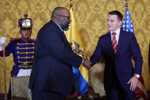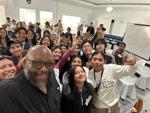“With all the things he did, good and bad, he was a diplomat for his nation,” Brown said. “I’m like, ‘I can do that.’ “
And Brown did, becoming United States ambassador to Ecuador in June after a 33-year career in the foreign service, most of it for the U.S. Agency for International Development. He served in countries throughout Africa, Central America, South America and the Caribbean region, along with a year that he volunteered in Afghanistan.
He also served for three years in the Peace Corps, where he met his future wife, Krista, when they trained together in Togo before he began working in Benin in 1991. She still works as a foreign service medical provider in Nigeria.

Art Brown, U.S. ambassador to Ecuador, with his wife, Krista, and children, Ella and Arrington, in Zimbabwe, where he previously served as mission director and deputy chief of mission for USAID.
Provided
But Brown’s career really grew from an audacious phone call he made in 1985 to the home of John Blackburn, then dean of admissions at the University of Virginia, where his parents had worked for decades in the hospital system. The university had denied his application to attend and then rejected his formal appeal — he acknowledges that his high school grades in math and science did not measure up to his work in history and social studies — but he never wavered.
Blackburn, who became the longest serving dean of admissions in UVa history, was the right person to ask. He had worked to open the university to students who never could have aspired to study there in the past. After Blackburn died in 2009, his obituary quoted him saying, “There are smart kids everywhere.”
“We had a very deep conversation,” recalled Brown, who following the call showed up at Blackburn’s office in pressed khaki pants, a navy blazer and blue-and-orange UVa tie. “As deep as you can have with a 17-year-old who’s telling you the university had made a mistake.”
He told the dean that if he couldn’t attend UVa, he would go to Parris Island, S.C., to join the U.S. Marine Corps.
“He was the linchpin,” he said of Blackburn. “He said, ‘Yes.'”
In return, Brown vindicated the dean’s belief in his abilities.
“That’s just so like Jack,” said Larry Sabato, director of the Center for Politics at UVa, who said Blackburn often would give students with few advantages the opportunity to show they could succeed at the university.
Sabato never knew Brown, but he knows his story. “He didn’t just talk his way in,” he said. “He had the ability to prove he could succeed.”

U.S. Ambassador Art Brown presents his credentials to Ecuadorian President Daniel Noboa in June.
Public Diplomacy Section, U.S. Embassy
Brown, now 57, also had parents who pushed him to seize opportunities they never had in the era of state Massive Resistance after the U.S. Supreme Court declared government segregation of public schools unconstitutional in 1954.
His father, Arthur Wardell “Mouse” Brown, who died in 2022, had worked at the UVa Hospital for 40 years, first operating its incinerator system and later serving as a respiratory therapy technician. He had attended Jackson P. Burley High School, then a school for Black students in Charlottesville and now a public middle school.
His mother, Emma Frances Arrington Brown, who turned 84 on Christmas Eve, had worked at the hospital for more than 40 years as a licensed practical nurse. A native of Madison County, she had attended George Washington Carver High School, a regional high school in Culpeper County for Black students from the Piedmont region.
Brown grew up in Keswick, in eastern Albemarle, on Black Cat Road, then unpaved. He thrived at Albemarle High School, where he played as offensive and defensive lineman on the football team. He focused mostly on the education he received in world and U.S. history, Latin and sociology from teachers who, because of their proximity to UVa, had furthered their own education with graduate and doctoral degrees.
His U.S. government teacher, Bob Weaver, insisted that Brown go to New York for a senior class trip to the United Nations. “He took me from a classroom in Albemarle and had me sitting in a seat in the UN General Assembly,” Brown said. “I was representing Angola.”
“I got to UVa super prepared because I had this incredible education,” he said. “(Dean) Blackburn put it all together.”
Brown still had to prove himself, first by taking summer courses to prepare for the college-level classes he would face at UVa. He wasn’t alone but was joined by other students who also needed more preparation, including some he said had been top achievers in small high schools in rural Southside and Appalachia.
He worked his way through school at restaurants and driving a university bus. John Hollis, one of his classmates whom he met in summer classes in 1985, remembers Brown coming to his dormitory first year on Saturdays to give him a haircut.
“School was work, but I loved it,” said Brown, who also was a walk-on player for the UVa football team his first year.
Then-Lt. Gov. Doug Wilder, who soon would become the nation’s first African American elected as governor, spoke at his graduation in 1989. Brown left UVa with a double-major degree in sociology and African American studies, having become a student of the African diaspora and slave trade that had shaped the world in which he had grown up in the Virginia Piedmont.
“I had a secret desire to learn the four primary languages of the transatlantic slave trade,” he said. (He learned Spanish and French, in addition to English, but never learned Portuguese.)
Since UVa, Brown has added master’s degrees in business administration from Johns Hopkins University and national security strategy from the National War College.
“I love education,” he said. “It is the key.”
However, Brown said that doesn’t mean every student has an equal opportunity to succeed on their own merits.
“Let’s not fool ourselves that our meritocracy is fair,” he said.

Ambassador Brown joined 50 College Horizons Outreach Program students at an English language summer camp in Ecuador’s northern province of Imbabura that included sessions on leadership and environmental awareness.
Public Diplomacy Section, U.S. Embassy in Ecuador
Brown brings this perspective to his work as ambassador in Ecuador, where levels of poverty and malnutrition are high, and too many opportunities come from the narcotics cartels that have used money and violence to entrench themselves in a country wedged between Colombia and Peru, two of the largest producers of cocaine in the world.
“I have experience in expanding public health and education programs, promoting economic development and environmental activities, and strengthening governance and rule-of-law projects,” he told the Senate Foreign Relations Committee in May 2023, nine months after President Joe Biden had nominated him to become ambassador.
“I have dedicated decades of service to helping countries show that democracy can deliver,” he said.
Sen. Tim Kaine, D-Va., a member of the committee and chairman of its subcommittee on the Western Hemisphere, was impressed by Brown’s personal story and his background in the foreign service and Peace Corps.
“He’s got a really great track record,” Kaine said in an interview.
His record is particularly important in Ecuador, which Kaine said had been courted by China for years before turning to the U.S. for help in economic development.
“He has the development background,” he said. “That’s what Ecuador wants: advice and assistance in growing their economy.”
Still, Brown’s nearly 20-month path to Senate confirmation was another education — in American politics. His confirmation and others were delayed through procedural “holds” by Sen. Rand Paul, R-Ky., and Sen. JD Vance, R-Ohio, who soon will be sworn in as vice president of the United States. It wasn’t personal, but the “holds” were a means to other political goals and, once met, were lifted.
His future depends on President-elect Donald Trump, who has not yet announced his choice as ambassador in Ecuador.
Kaine said he hopes that Trump will keep career diplomats in their posts, at least until the Senate can confirm their replacements.
“We just need a pro there who can help us put our best foot forward,” he said.
Brown said he would be “happy to serve” the new president, but emphasized that his oath is to the U.S. Constitution. “There will be no other test of loyalty,” he said.

U.S. Ambassador Art Brown greets a resident of Esmeraldas during a visit to the province in northern Ecuador.
Public Diplomacy Section, U.S. Embassy
Many of Trump’s policy goals will require work in Ecuador, where the U.S. is trying to prevent the flow of narcotics, arms and human trafficking by drug cartels in Mexico. “Ultimately, this nonsense hits our border,” Brown said. “It affects our national security.”
“I’m certainly looking forward to the new administration,” he said. “There seems to be more of a high focus on Central and South America and the Caribbean. Our borders and national security matter.”
Brown, in his first seven months as ambassador, has worked to strengthen the police and military in Ecuador, but said he’s also tried to lift up the marginalized communities that narcotics traffickers exploit, trying to give young people options other than gangs.
That begins with education.
“When I work in environments where young people don’t have that as an option, it’s disheartening,” Brown said. “I work even harder.”



Close

The Rotunda at the University of Virginia, which has been closed for the past two years to restore some of its original architecture and make more space for classrooms and study areas, is set to reopen Sept. 26. Along with the renovations, the roughly $58 million project led to archaeological discoveries.

Senior Director of Media Relations McGregor McCance makes introductions during a tour of the newly renovated Rotunda at the University of Virginia in Charlottesville, Va.

Senior Director of Media Relations McGregor McCance makes introductions during a tour of the newly renovated Rotunda at the University of Virginia in Charlottesville, Va. Photo/The Daily Progress/Andrew Shurtleff

University architect Alice J. Raucher speaks with media during a tour of the newly renovated Rotunda at the University of Virginia in Charlottesville, Va. Photo/The Daily Progress/Andrew Shurtleff

The renovated Rotunda at the University of Virginia in Charlottesville.

New staircases on the first floor in the newly renovated Rotunda at the University of Virginia in Charlottesville, Va. Photo/The Daily Progress/Andrew Shurtleff


Senior Historic Preservation Planner Brian E. Hogg gives a detailed tour of the dome room in the newly renovated Rotunda at the University of Virginia in Charlottesville, Va. Photo/The Daily Progress/Andrew Shurtleff


Senior Historic Preservation Planner Brian E. Hogg gives a detailed tour of the dome room in the newly renovated Rotunda at the University of Virginia in Charlottesville, Va. Photo/The Daily Progress/Andrew Shurtleff

Senior Historic Preservation Planner Brian E. Hogg gives a detailed tour of the dome room in the newly renovated Rotunda at the University of Virginia in Charlottesville, Va. Photo/The Daily Progress/Andrew Shurtleff

Daily Progress Publisher Rob Jiranek takes a photo in the newly renovated Rotunda at the University of Virginia in Charlottesville, Va. Photo/The Daily Progress/Andrew Shurtleff

The dome room in the newly renovated Rotunda at the University of Virginia in Charlottesville, Va. Photo/The Daily Progress/Andrew Shurtleff

The dome room in the newly renovated Rotunda at the University of Virginia in Charlottesville, Va. Photo/The Daily Progress/Andrew Shurtleff

Newly designed staircases on the 2nd floor in the newly renovated Rotunda at the University of Virginia in Charlottesville, Va. Photo/The Daily Progress/Andrew Shurtleff


BOV room on the 2nd floor in the newly renovated Rotunda at the University of Virginia in Charlottesville, Va. Photo/The Daily Progress/Andrew Shurtleff

A new lounge on the 2nd floor in the newly renovated Rotunda at the University of Virginia in Charlottesville, Va. Photo/The Daily Progress/Andrew Shurtleff

The upper mezzanine level is now open above the dome room in the newly renovated Rotunda at the University of Virginia in Charlottesville, Va. Photo/The Daily Progress/Andrew Shurtleff

A new museum dedicated to the Rotunda has been erected on the bottom level in the newly renovated Rotunda at the University of Virginia in Charlottesville, Va. Photo/The Daily Progress/Andrew Shurtleff







The Rotunda at the University of Virginia, which has been closed for the past two years to restore some of its original architecture and make more space for classrooms and study areas, is set to reopen Sept. 26. Along with the renovations, the roughly $58 million project led to archaeological discoveries.

Senior Director of Media Relations McGregor McCance makes introductions during a tour of the newly renovated Rotunda at the University of Virginia in Charlottesville, Va.

Senior Director of Media Relations McGregor McCance makes introductions during a tour of the newly renovated Rotunda at the University of Virginia in Charlottesville, Va. Photo/The Daily Progress/Andrew Shurtleff

University architect Alice J. Raucher speaks with media during a tour of the newly renovated Rotunda at the University of Virginia in Charlottesville, Va. Photo/The Daily Progress/Andrew Shurtleff

The renovated Rotunda at the University of Virginia in Charlottesville.

New staircases on the first floor in the newly renovated Rotunda at the University of Virginia in Charlottesville, Va. Photo/The Daily Progress/Andrew Shurtleff


Senior Historic Preservation Planner Brian E. Hogg gives a detailed tour of the dome room in the newly renovated Rotunda at the University of Virginia in Charlottesville, Va. Photo/The Daily Progress/Andrew Shurtleff


Senior Historic Preservation Planner Brian E. Hogg gives a detailed tour of the dome room in the newly renovated Rotunda at the University of Virginia in Charlottesville, Va. Photo/The Daily Progress/Andrew Shurtleff

Senior Historic Preservation Planner Brian E. Hogg gives a detailed tour of the dome room in the newly renovated Rotunda at the University of Virginia in Charlottesville, Va. Photo/The Daily Progress/Andrew Shurtleff

Daily Progress Publisher Rob Jiranek takes a photo in the newly renovated Rotunda at the University of Virginia in Charlottesville, Va. Photo/The Daily Progress/Andrew Shurtleff

The dome room in the newly renovated Rotunda at the University of Virginia in Charlottesville, Va. Photo/The Daily Progress/Andrew Shurtleff

The dome room in the newly renovated Rotunda at the University of Virginia in Charlottesville, Va. Photo/The Daily Progress/Andrew Shurtleff

Newly designed staircases on the 2nd floor in the newly renovated Rotunda at the University of Virginia in Charlottesville, Va. Photo/The Daily Progress/Andrew Shurtleff


BOV room on the 2nd floor in the newly renovated Rotunda at the University of Virginia in Charlottesville, Va. Photo/The Daily Progress/Andrew Shurtleff

A new lounge on the 2nd floor in the newly renovated Rotunda at the University of Virginia in Charlottesville, Va. Photo/The Daily Progress/Andrew Shurtleff

The upper mezzanine level is now open above the dome room in the newly renovated Rotunda at the University of Virginia in Charlottesville, Va. Photo/The Daily Progress/Andrew Shurtleff

A new museum dedicated to the Rotunda has been erected on the bottom level in the newly renovated Rotunda at the University of Virginia in Charlottesville, Va. Photo/The Daily Progress/Andrew Shurtleff






Source link : http://www.bing.com/news/apiclick.aspx?ref=FexRss&aid=&tid=6775274e3ec84148abef4990d0a1244c&url=https%3A%2F%2Frichmond.com%2Fnews%2Fstate-regional%2Fart-brown-ambassador-ecuador-uva-albemarle%2Farticle_5cd30176-c3ad-11ef-9bfe-63bf6da2d95b.html&c=16998343483351896373&mkt=en-us
Author :
Publish date : 2024-12-31 20:30:00
Copyright for syndicated content belongs to the linked Source.











